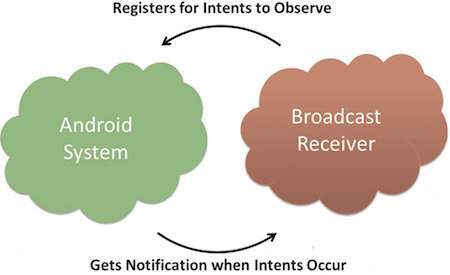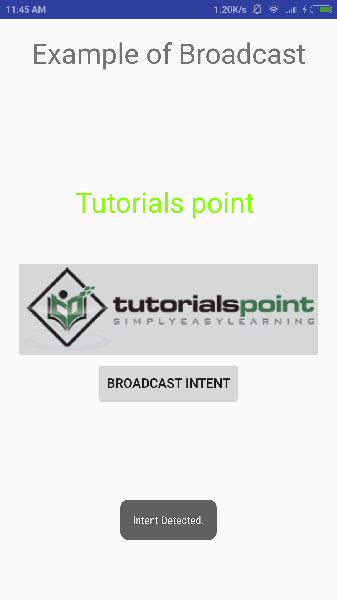- Android中的广播接收器示例
- Android中的广播接收器示例(1)
- 没有内部 android 工作室的广播接收器 - 任何代码示例
- android 通过意图广播接收器检测屏幕 - Java (1)
- 耙式接收器(1)
- 耙式接收器
- android 通过意图广播接收器检测屏幕 - Java 代码示例
- android 动态广播组 (1)
- 在 python 中广播(1)
- 在 python 代码示例中广播
- android 动态广播组 - 任何代码示例
- 如何从 android 中的广播组获取数据 - Java (1)
- NumPy-广播(1)
- NumPy-广播
- 如何从 android 中的广播组获取数据 - Java 代码示例
- 模拟通信-接收器(1)
- 模拟通信-接收器
- 在 Julia 中跨数组广播
- 在 Julia 中跨数组广播(1)
- 级联中的接收器模式 - 无论代码示例
- SharePoint-功能\事件接收器
- SharePoint-功能\事件接收器(1)
- Kotlin 中带有接收器的函数字面量(1)
- Kotlin 中带有接收器的函数字面量
- 广播消息的 Shell 脚本(1)
- 广播消息的 Shell 脚本
- Python|使用 NumPy 数组进行广播(1)
- Python|使用 NumPy 数组进行广播
- 互联网广播流的 python 代码 - Python (1)
📅 最后修改于: 2021-01-05 04:52:27 🧑 作者: Mango
广播接收器仅响应来自其他应用程序或系统本身的广播消息。这些消息有时称为事件或意图。例如,应用程序还可以启动广播,以使其他应用程序知道某些数据已下载到设备中并可供他们使用,因此,这是广播接收器,它将拦截此通信并启动适当的操作。
要使BroadcastReceiver用于系统的广播意图,需要执行以下两个重要步骤-
-
创建广播接收器。
-
注册广播接收器
如果要实现您的自定义意图,还有另外一个步骤,那么您将必须创建并广播这些意图。
创建广播接收器
广播接收器被实现为BroadcastReceiver类的子类,并且重写了onReceive()方法,在该方法中,每个消息均作为Intent对象参数被接收。
public class MyReceiver extends BroadcastReceiver {
@Override
public void onReceive(Context context, Intent intent) {
Toast.makeText(context, "Intent Detected.", Toast.LENGTH_LONG).show();
}
}
注册广播接收器
应用程序通过在AndroidManifest.xml文件中注册广播接收器来侦听特定的广播意图。考虑一下,我们将为系统生成的事件ACTION_BOOT_COMPLETED注册MyReceiver ,一旦Android系统完成启动过程,系统就会触发该事件。

广播接收器
现在,每当您的Android设备启动时,它将被BroadcastReceiver MyReceiver拦截,并且将执行onReceive()中的已实现逻辑。
在Intent类中,有几个系统生成的事件定义为最终的静态字段。下表列出了一些重要的系统事件。
| Sr.No | Event Constant & Description |
|---|---|
| 1 |
android.intent.action.BATTERY_CHANGED Sticky broadcast containing the charging state, level, and other information about the battery. |
| 2 |
android.intent.action.BATTERY_LOW Indicates low battery condition on the device. |
| 3 |
android.intent.action.BATTERY_OKAY Indicates the battery is now okay after being low. |
| 4 |
android.intent.action.BOOT_COMPLETED This is broadcast once, after the system has finished booting. |
| 5 |
android.intent.action.BUG_REPORT Show activity for reporting a bug. |
| 6 |
android.intent.action.CALL Perform a call to someone specified by the data. |
| 7 |
android.intent.action.CALL_BUTTON The user pressed the “call” button to go to the dialer or other appropriate UI for placing a call. |
| 8 |
android.intent.action.DATE_CHANGED The date has changed. |
| 9 |
android.intent.action.REBOOT Have the device reboot. |
广播自定义意图
如果您希望应用程序本身应生成并发送自定义意图,则必须使用活动类中的sendBroadcast()方法来创建并发送这些意图。如果您使用sendStickyBroadcast(Intent)方法,则该Intent是粘性的,这意味着您要发送的Intent在广播完成后仍然存在。
public void broadcastIntent(View view) {
Intent intent = new Intent();
intent.setAction("com.tutorialspoint.CUSTOM_INTENT");
sendBroadcast(intent);
}
这个意图com.tutorialspoint.CUSTOM_INTENT也可以通过类似于我们重新注册系统生成的意图的方式进行注册。
例
本示例将向您说明如何创建BroadcastReceiver来拦截自定义意图。熟悉自定义意图后,即可对应用程序进行编程以拦截系统生成的意图。因此,让我们按照以下步骤修改我们在“ Hello World示例”一章中创建的Android应用程序-
| Step | Description |
|---|---|
| 1 | You will use Android studio to create an Android application and name it as My Application under a package com.example.tutorialspoint7.myapplication as explained in the Hello World Example chapter. |
| 2 | Modify main activity file MainActivity.java to add broadcastIntent() method. |
| 3 | Create a new java file called MyReceiver.java under the package com.example.tutorialspoint7.myapplication to define a BroadcastReceiver. |
| 4 | An application can handle one or more custom and system intents without any restrictions. Every intent you want to intercept must be registered in your AndroidManifest.xml file using |
| 5 | Modify the default content of res/layout/activity_main.xml file to include a button to broadcast intent. |
| 6 | No need to modify the string file, Android studio take care of string.xml file. |
| 7 | Run the application to launch Android emulator and verify the result of the changes done in the application. |
以下是修改后的主要活动文件MainActivity.java的内容。该文件可以包括每个基本生命周期方法。我们添加了broadcastIntent()方法以广播自定义意图。
package com.example.tutorialspoint7.myapplication;
import android.app.Activity;
import android.content.Intent;
import android.os.Bundle;
import android.view.View;
public class MainActivity extends Activity {
/** Called when the activity is first created. */
@Override
public void onCreate(Bundle savedInstanceState) {
super.onCreate(savedInstanceState);
setContentView(R.layout.activity_main);
}
// broadcast a custom intent.
public void broadcastIntent(View view){
Intent intent = new Intent();
intent.setAction("com.tutorialspoint.CUSTOM_INTENT"); sendBroadcast(intent);
}
}
以下是MyReceiver.java的内容:
package com.example.tutorialspoint7.myapplication;
import android.content.BroadcastReceiver;
import android.content.Context;
import android.content.Intent;
import android.widget.Toast;
/**
* Created by TutorialsPoint7 on 8/23/2016.
*/
public class MyReceiver extends BroadcastReceiver{
@Override
public void onReceive(Context context, Intent intent) {
Toast.makeText(context, "Intent Detected.", Toast.LENGTH_LONG).show();
}
}
以下将修改AndroidManifest.xml文件的内容。在这里,我们添加了
以下是res / layout / activity_main.xml文件的内容,其中包括一个用于广播我们的自定义意图的按钮-
让我们尝试运行修改后的Hello World!我们刚刚修改的应用程序。我假设您在进行环境设置时已创建了AVD 。要从Android Studio运行该应用,请打开您项目的活动文件之一,然后点击运行 工具栏中的图标。 Android Studio将应用程序安装在您的AVD上并启动它,如果设置和应用程序一切正常,它将显示在“模拟器”窗口下面-
工具栏中的图标。 Android Studio将应用程序安装在您的AVD上并启动它,如果设置和应用程序一切正常,它将显示在“模拟器”窗口下面-

现在要广播我们的自定义意图,让我们单击“广播意图”按钮,这将广播我们的自定义意图“ com.tutorialspoint.CUSTOM_INTENT” ,它将被我们注册的BroadcastReceiver即MyReceiver拦截,并且根据我们实现的逻辑,祝酒词将出现在底部模拟器的如下-

您可以尝试实现其他BroadcastReceiver来拦截系统生成的意图,例如系统启动,更改日期,电池电量低等。